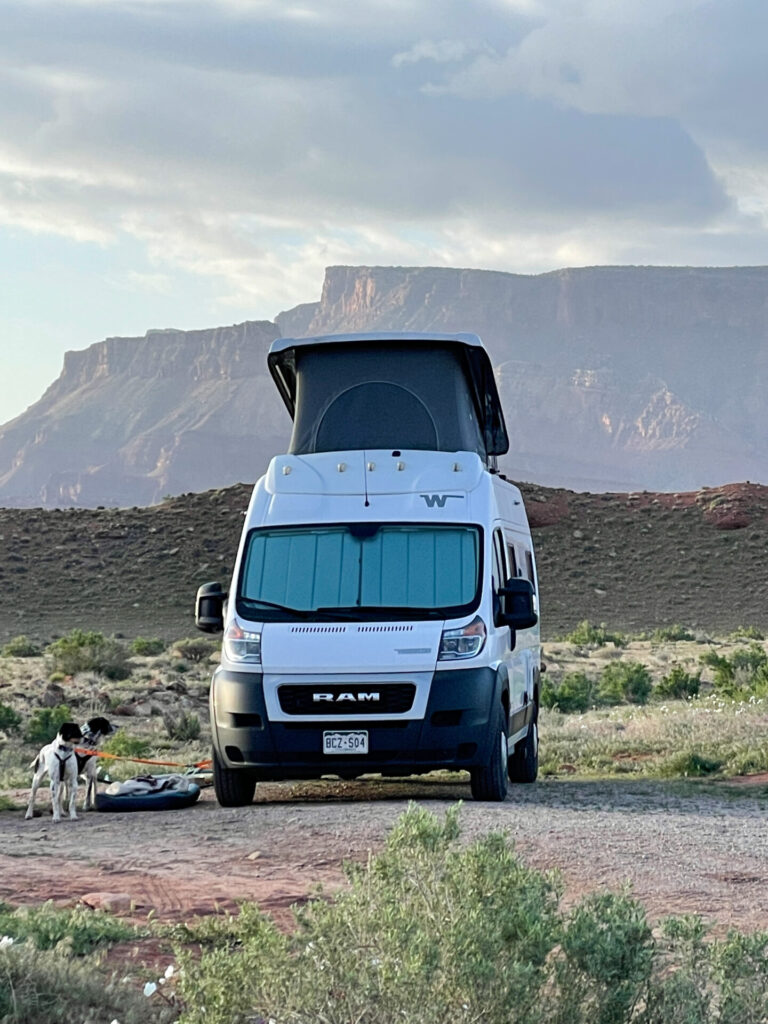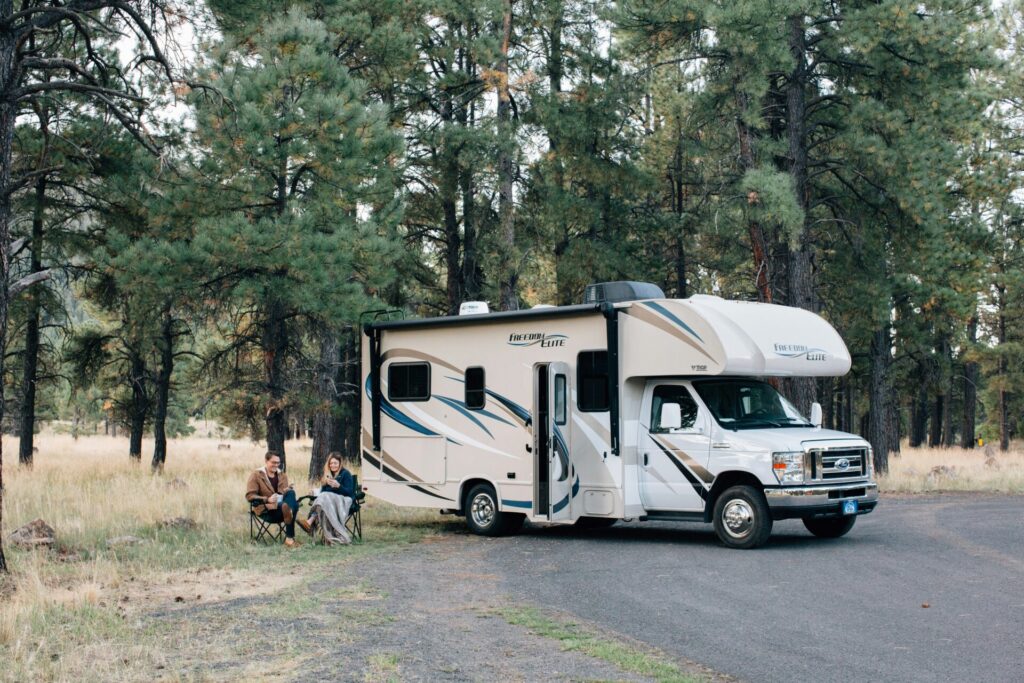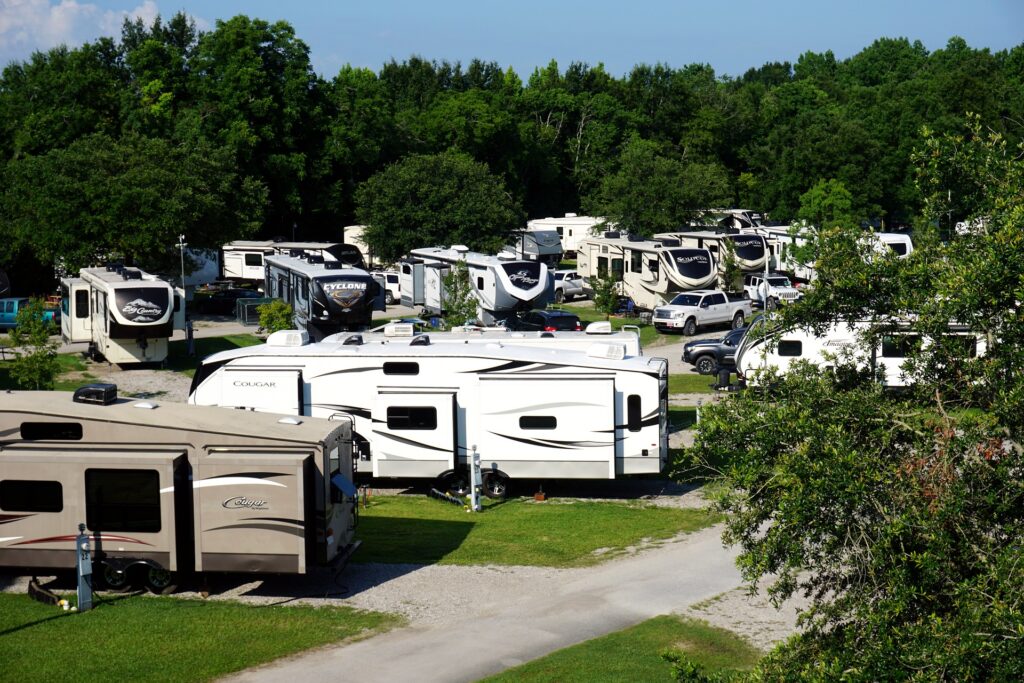
RV parking is something many new RVers worry about. This is understandable, as parking a big rig can be tricky—and if you’re driving a trailer, things become even more difficult! Fortunately, there are plenty of ways to make RV parking a little easier and safer.
RV Parking Tips
Parking an RV may sound simple enough when you read the brief explanation above, but there are some more tips and tricks you will want to have up your sleeve before you dive in. Use the tips below to make your RV parking experience go as smoothly as possible.
Choosing the Right Spot for Your RV
One way you can make your RV parking experience a bit easier is by choosing the right campsite. Try to choose a large site without any trees or other obstructions near the parking area. Finding a site that is relatively level is also important, as leveling an RV when parked on a very uneven surface can be quite difficult.
Another thing to look out for? The campsites around the site you choose—particularly the one across the street from your site. Make sure there are no vehicles in the way of backing into the site you choose.
Safety Tips for RV Parking
Keeping everyone safe while parking your RV is also incredibly important. Always keep kids and pets in the vehicle until you are finished parking. Have an adult spotter get out of the vehicle and help direct you, using either walkie-talkies or your cell phones to communicate in order to avoid shouting.
A backup camera on your rig can also be helpful if you want to be absolutely sure you can see everything around you.
Maximizing Space in RV Parking
Generally speaking, the more space you have to spread out in your campsite, the better. For this reason, we recommend doing what you can to maximize your space while parking your RV, especially if you’re staying in a campground with smaller spots.
RV campsites are divided by the hookups, meaning your campsite starts at your power pedestal and ends at your neighbor’s pedestal. You can take full advantage of the space offered by your campsite by parking as close to the power pedestal as possible. Just be sure you don’t run into the pedestal or the water spigot!
Finding the Perfect Spot for Your RV
We discussed finding the ideal campsite for making RV parking easy above, but what about finding the perfect campsite or storage space? How do you go about determining which ones might be best for your situation?
Finding the Best RV Storage
When looking for RV storage, consider the location of the lot, as well as how secure it is. Is the storage spot covered? Is it paved? Does it include any sort of hookups?
While everyone has different things they look for in an RV storage spot, these are some good things to find out while narrowing down your options.
Finding the Best RV Campgrounds
Looking for the ideal campground? Location matters in this instance as well.
Make sure it is close to home if that’s what you prefer, or close to attractions you plan to visit if you are using your RV for sightseeing. Find out how big the campsites are to determine if you will fit and try to book one that is level.
It’s also good to learn what kinds of hookups are included at the site you plan to book, as well as if there are other amenities included in your stay.
RV Parking Basics
Let’s discuss the most basic aspects of RV parking: where you might need to park, how you might need to park, and the basic rules for how to go about it. Once you know these things, you’ll be well on your way to being an RV parking expert.
Types of RV Parking
There are several different situations in which you may need to park your RV. You might park in a campsite of course, but you could also need to park in a driveway, in a parking lot, or even on the street. These situations could be as simple as pulling through the space in question, but in most cases you will need to back in, and in some instances, parallel parking might be a good skill to have.
If you’re headed out on your first trip, you might consider requesting a pull-through spot. However, it is a good idea to practice backing into a spot before you leave home just in case it comes up.
Understanding the Basics of RV Parking
Pull-through parking in an RV is easy enough: Just pull through the campsite while watching your corners to be sure you don’t hit anything. You’ll also want to do your best to get the angle right.
Backing an RV into a campsite is where things get a little more challenging. To begin, make sure you are headed the right direction down the road to your site. Most campsites are angled and you want to be backing in at a gentle angle, not a sharp one. Pull a bit beyond the campsite you wish to occupy and put your vehicle in reverse. Slowly and cautiously back the RV up into the spot.
If you are backing a trailer, put your hand on the bottom of the wheel and know that the direction you move your hand to turn is the direction the back end of your trailer will go. This takes some getting used to, but you will master it with some practice! If you’re driving a motorhome, the back end of your rig will move the same way a smaller vehicle would.

Common Challenges in RV Parking
There are a few challenges you may encounter when parking your RV. These can be frustrating, especially if you’re new to RV parking and find the process a bit overwhelming without any added challenges.
The good news? There are ways to overcome these difficulties and get on with your camping fun.
Not Enough Room to Turn
It doesn’t happen often, but sometimes you will come across a campsite that is so close to the sites across the street that you can’t finagle your way in. If you’ve tried inching your way in, going back and forth several times, and you just aren’t going to make it, you have options.
First, if the reason you aren’t fitting is because a neighbor’s vehicle is in the way, simply go knock on the door and ask them if they can scoot over a bit. More RVers are happy to help, and some may even be willing to give a few parking tips.
If the problem is not with a moveable object but with another RV or a tree, fence, or power pedestal, you might have to head to the office and ask for another site (or look for another site if the campsites are FCFS). This isn’t ideal, but if you won’t fit, you won’t fit.
The Spot is Too Short
If you are assigned a site by the campground, this is probably not a problem you’ll have to deal with. However, if you’re headed to a campground where sites are first-come, first-serve and you arrive to find very few sites available, it could happen that you end up with a campsite that is a tad short for your rig. In this case, you may find that if you put the back end of your RV over the back end of the site, you fit just fine.
Of course, this only works if there are no obstructions behind you!
Unlevel Parking Surface
Nobody wants to spend their trip feeling as though they’re staying in a fun house. Besides, parking your RV at an angle isn’t good for the RV fridge. So what do you do if you get into your campsite only to find it is totally unlevel?
Luckily, this is a completely solvable problem. To level an RV, simply place leveling blocks under the wheels on whichever side needs to be raised. If you’re leveling a motorhome, you will need to add blocks to the front or back as well, depending on if you need to be higher in the front or the back. With trailers, simply use blocks to level the RV side-to-side and then use the tongue jack to finish the job.
Low Hanging Branches
You always, always want to check any campsite you plan to pull into before you pull into it. When doing this, look up. If you notice low hanging branches that will brush the top of your camper, don’t park. Instead, head to the office and let them know the tree needs to be trimmed in order for you to safely park your rig. After all, you don’t want to damage your camper roof while parking!

RV Parking FAQs
Still have questions about RV parking? We get it, there’s a lot to learn. Below are some of the most frequently asked questions with answers. Use this info to help yourself feel more comfortable parking an RV.
What is the best surface to park an RV on?
Generally speaking, asphalt and concrete are the best surfaces to park an RV on. Gravel campsites are also perfectly acceptable.
These surfaces tend to be the most level and you are less likely to have pests enter your rig when parked on a hard surface. Additionally, you are less likely to deal with puddles and mud during rainy weather when parked on one of these surfaces.
Is it OK to park an RV on grass?
Asphalt, concrete, and gravel might be the best surfaces to park an RV on, but is it okay to park in the grass? The answer is yes, it’s totally okay to park your RV in grass.
That said, you will want to avoid parking in tall grass and take steps to deter mice and other pests. You should also be aware that it is possible to get stuck in the mud and grass when it rains, so it’s best to avoid moving the rig until the ground has dried if at all possible.
Where is the best place to park a camper?
This depends on what you are parking the camper for:
- If you are parking for a quick overnight, a Cracker Barrel or Walmart parking lot might do the trick, provided you’ve gotten permission to stay there.
- For longer stays, a legal boondocking spot, the land of a friend or family member, or an official campsite will be needed.
- Looking for RV storage? A storage lot, your own yard, or the land of a friend or family member is best for this.
In all cases, a level parking area on asphalt, concrete, or gravel is ideal, but obviously this is not always feasible, so just do the best you can.
What length RV will fit in a parking space?
RV campsites come in all sizes. In order to ensure you will fit in a spot, check the campground website or call the office before booking.
Hoping to park an RV in a traditional parking spot? Usually, traditional parking spots are between 8.5 and 9 feet wide, and between 16 and 20 feet long. A very small class B RV will fit in a standard parking spot, but not much else. Fortunately, it is often possible to find several parking spots together where you can park an RV in order to visit a place of business.
There you have it! Everything you need to know about RV parking. Yes, it’ll be a little nerve-wracking at first, but use the tips above and do a bit of practice before you hit the road and you should be good to go. In fact, we’re betting that after your first RV rental with RVshare, you’ll be parking like a champ! Find the perfect RV.






